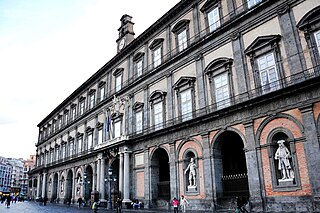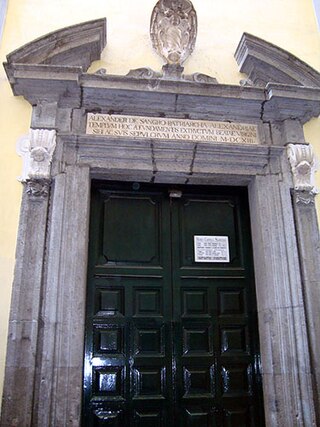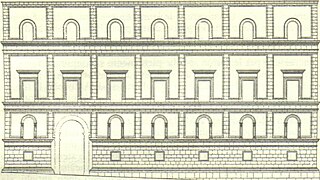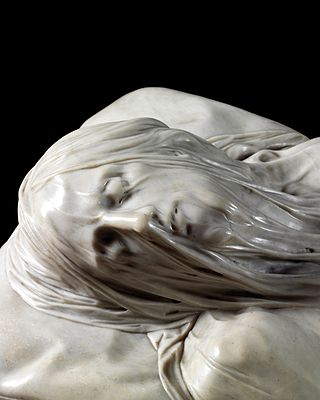
The properties of the Holy See are regulated by the 1929 Lateran Treaty signed with the Kingdom of Italy. Although part of Italian territory, some of them enjoy extraterritoriality similar to those of foreign embassies.

San Severo is a comune of c. 51,919 inhabitants in the province of Foggia, Apulia, Southern Italy. Rising on the foot of the spur of Gargano, San Severo adjoins the communes of Apricena in the north, Rignano Garganico and San Marco in Lamis in the east, Foggia and Lucera in the south, and Torremaggiore and San Paolo di Civitate in the west.

Torricella Peligna is a comune and town in the Province of Chieti in the Abruzzo region of Italy.

Gesù Nuovo is the name of a church and a square in Naples, Italy. They are located just outside the western boundary of the historic center of the city. To the southeast of the spire, one can see a block away the Fountain of Monteoliveto and the piazza of the church of Sant'Anna dei Lombardi. The square is a result of the expansion of the city to the west beginning in the early 16th century under the rule of Spanish viceroy Pedro Alvarez de Toledo. The square of Gesù Nuovo contains three prominent landmarks:

The Royal Palace of Naples is a palace, museum, and historical tourist destination located in central Naples, southern Italy.

The Cappella Sansevero is a chapel located on Via Francesco de Sanctis 19, just northwest of the church of San Domenico Maggiore, in the historic center of Naples, Italy. The chapel is more properly named the Chapel of Santa Maria della Pietà. It contains works of Rococo art by some of the leading Italian artists of the 18th century.

Sant'Anna dei Lombardi,, and also known as Santa Maria di Monte Oliveto, is an ancient church and convent located in piazza Monteoliveto in central Naples, Italy. Across Monteoliveto street from the Fountain in the square is the Renaissance palace of Orsini di Gravina.

Giuseppe Piermarini was an Italian architect who trained with Luigi Vanvitelli in Naples and designed the Teatro alla Scala in Milan (1776–78), which remains the work by which he is remembered. Indeed, il Piermarini serves as an occasional journalistic synonym for the celebrated opera house. Piermarini was appointed professor in the Academy of Fine Arts of Brera, better known as Brera Academy, Milan, when it was formally founded in 1776.

Raimondo di Sangro, Prince of Sansevero was an Italian nobleman, inventor, soldier, writer, scientist, alchemist and freemason best remembered for his reconstruction of the Sansevero Chapel in Naples.

Christianity and religion in general has always been an important part of the social and cultural life of Naples. It is the seat of the Archdiocese of Naples, and the Catholic faith is highly important to the people of Naples and there are hundreds of historic churches in the city. The Cathedral of Naples is the most important place of worship in the city, each year on September 19 it hosts the Miracle of Saint Januarius, the city's patron saint. In the miracle which thousands of Neapolitans flock to witness, the dried blood of Januarius is said to turn to liquid when brought close to relics said to be of his body: this is one of the most important traditions for Neapolitans.

Giuseppe Sanmartino or Giuseppe Sammartino was an Italian sculptor during the Rococo period.

The Palazzo of Monte di Pietà is a historic building located along the lower decumanus of Naples, Italy. The lower decumanus is also known as Spaccanapoli street. It housed the Mount of Piety or Christian bank in Naples.

The Palazzo del Panormita is a Renaissance style palace in central Naples. It rises alongside the narrow via Nilo, near via Spaccanapoli, where it is called San Biagio dei Librai, diagonally from Santa Maria Assunta dei Pignatelli, adjacent to the Piazza del Nilo with the Nile God statue. It is south of Palazzo d’Afflitto and the Palazzo Spinelli di Laurino. The palace was initially commissioned prior to 1450 by Antonio Beccadelli, (1394–1471), called Il Panormita, who was a prominent Italian poet, canon lawyer, scholar, diplomat, and chronicler. It has since gone through many owners, including Giacomo Capece Galeota, a regent in the Tribunal of the Vicariate.

The Palazzo Orsini di Gravina is a Renaissance-style palace on number 3 Via Monteoliveto, in the San Lorenzo quarter of Rione San Giuseppe-Carità, of central Naples, Italy. Since 1940, it has housed the Faculty of Architecture of the University of Naples. It is located across the street and a few doors north of the sleek and modern Palazzo delle Poste. Across the street at the north end of the palace, is the Piazza Monteoliveto with its Fountain and the church of Sant'Anna dei Lombardi.

The Palazzo Ricca is a monumental palace, located on the southernmost end of Via dei Tribunali #213, in central Naples, region of Campania, Italy. It presently houses the archives of the Foundation of the Istituto Banco di Napoli. The palace is just down the street from the entrance to Castel Capuano

The Palazzo Zevallos Stigliano is a Baroque palace located on Via Toledo number 185 in the quartiere San Ferdinando of central Naples, Italy. It is also called the Palazzo Zevallos or Palazzo Colonna di Stigliano, and since 2014 serves as a museum of artworks, mainly spanning the 17th through the early 20th centuries, sponsored by the Cultural Project of the bank Intesa Sanpaolo. This museum is linked to the Museum or Gallerie di Piazza Scala in Milan and the Museum at Palazzo Leoni Montanari in Vicenza, also owned by the Bank.

Veiled Christ is a carved marble sculpture by the Neapolitan artist Giuseppe Sanmartino (1720-1793) completed in 1753. The sculpture is formed from a single block of white marble, and was commissioned by Raimondo di Sangro, a prince of Sansevero, as the centerpiece of the Cappella Sansevero, in Naples, Italy.

Modesty or Chastity or Veiled Truth by Antonio Corradini is a sculpture completed in 1752 during the Rococo period. Corradini was commissioned by Raimondo di Sangro to sculpt a memorial for his mother in the Cappella Sansevero in Naples, where the marble sculpture still remains.

Palazzo di Sangro, also known as either Palazzo de Sangro di Sansevero or Palazzo Sansevero, is a late-Renaissance-style aristocratic palace facing the church of San Domenico Maggiore, separated by the via named after the church, in the city center of Naples, Italy. Part of the palace facade faces the piazza in front of the church, which is also bordered to the south by the Palazzo di Sangro di Casacalenda.

The d'Afflitto family is an ancient princely family originally from Amalfi, documented since the IX century, and spread throughout southern Italy.




















